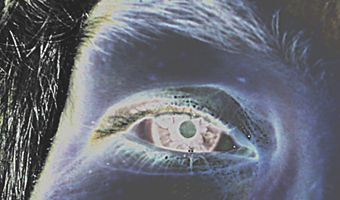Big Brother Appears in England: Posters of Staring Eyes Reduce Thefts

Boasting a close-up photograph of a man's eyes beneath the words "We Are Watching You," posters were placed above bicycle racks in three locations at Newcastle University during a two-year experiment. This simple strategy reduced thefts from these racks by 62%, say researchers.
Professor Melissa Bateson and Professor Daniel Nettle of the Centre for Behaviour and Evolution, and Ken Nott, Deputy Team Leader for security in the Estates Security Service at Newcastle University, described their findings in a paper published in the journal PLOS ONE.
Unfortunately, the laws of compensation immediately came into play: in places without the signs, bike theft went up by 63%. Crime had not been eliminated by the posters, these findings suggest, it had simply been displaced to other locations.
Nott said, "I had followed previous work done by this team and thought it might be able to make a difference to levels of crime, so I decided to suggest this experiment." In a 2006 study, Bateson and Nettle examined the impact of images of eyes on contributions to an honesty box in a tea room. People put nearly three times more money in the box when under the influence of watchful eyes. In 2010 the researchers found people to be more likely to clean away their tray after a meal if eyes watched them.
By implementing the experiment, Nott was hoping to reverse a negative trend. In England and Wales generally, there were 115,905 bicycle thefts reported to police between April 2011 and May 2012 representing an increase of 6% compared to the previous year.
In their introductory notes to the bicycle rack study, the authors acknowledge that their central idea --- observation reduces crime --- is far from original. Situational crime prevention includes formal surveillance, such as closed-circuit television, as well as natural surveillance, such as designing an environment so locations are in sight of passersby. The 'watching eyes' effect differs from these in that actual observation is completely absent --- only the cues of being watched are present.
In fact, many place-based crime prevention measures, the authors wrote, are quite effective. For example, CCTV surveillance reduces crime by an average of around 7%, with larger reductions of around 51% specifically for interventions in car parks. Improved street lighting shows average reductions around 22%.
With this experiment, the authors sought to expand the results of contemporary behavioral science, which finds that the mind often relies on fast, simple, non-conscious 'rules of thumb' to make decisions. Human decision-making can be manipulated, the authors indicate, by the way an environment appears or information is presented.
Nott said, "The results were clear and we have now put these pictures up across all the bike racks on the campus."
The experiment has also inspired the British Transport Police to trial it with train Company C2C on a route between Fenchurch Street Station in London and Southend in Essex.



























